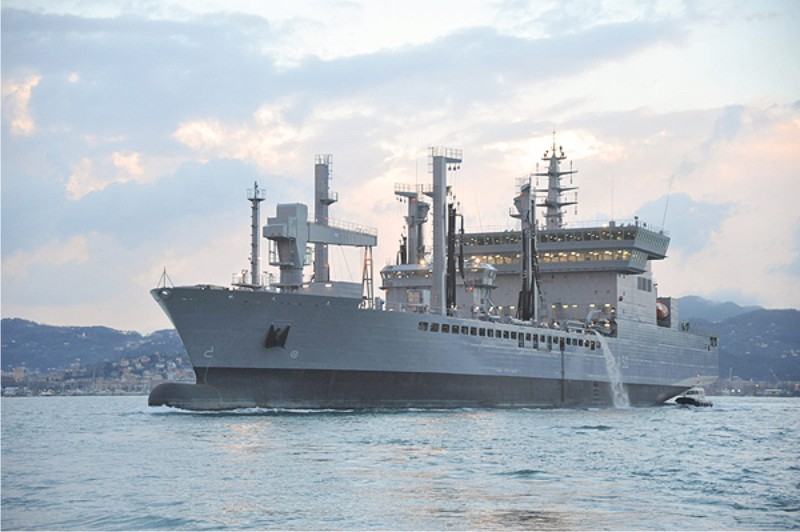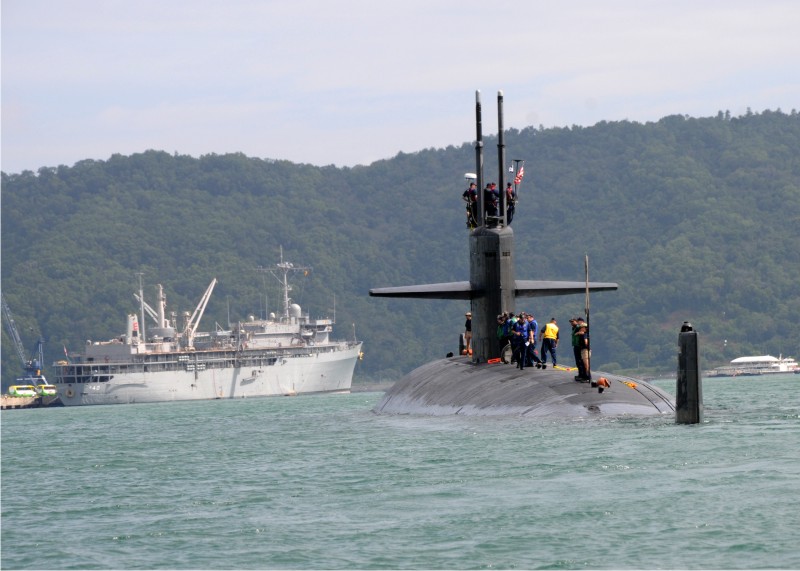
Welcome to MSW’s Scuttlebutt! Here’s the news for the day.

The First Fleet Tanker for the Indian Navy Delivered In Mumbai
Source: Fincantieri
Today in Mumbay there was the commissioning ceremony for the “Deepak”, the first of two fleet tankers ordered from Fincantieri by the Indian Navy.

Present at the ceremony were A.K. Antony, the Indian Minister of the Defence, Admiral Nirmal Varma, Chief of Naval Staff of the Indian Navy, and Corrado Antonini, Chairman of Fincantieri. The order is the first surface vessel India has ordered from a European company, gained in competition against prominent international players, in particular from Russia and Korea.
With a displacement at full load of 27,500 tonnes, the 175 metre long fleet tanker, with a beam of 25 metres and a height of 19, has two 10,00 kW diesel engines for propulsion and can reach a maximum speed of 20 knots. Further features include a propulsion system with an adjustable propeller and a flight deck for medium-heavy helicopters (up to 10 tons).
The ship can accommodate 250 crew and personnel. Thanks to double hatches the vessel can supply four ships at the same time.
In accordance with the new Marpol regulations of the International Maritime Organization regarding safeguarding of the environment, the ship has been built with a double hull which will afford greater protection to the fuel tanks thereby avoiding the risk of pollution in case of collision or damage.
Cooperation with India commenced in 2004 when Fincantieri signed two contracts with Cochin shipyard for the design of the engine, technology transfer and provision of complementary services for the construction of Indigenous Aircraft Carrier (IAC). In addition, in 2007, the company delivered the “Sagar Nidhi”, an oceanographic vessel for the National Institute of Ocean Technology (NIOT) in Madras, which is already in service off the Indian coast to the full satisfaction of the customer.
Fincantieri considers the market in the East strategic and holds in high regard the development of cooperation with its prestigious Indian partner, proof of which is both the opening in recent years of a representative office in New Delhi and, now, of a Fincantieri technical support unit in India in order to guarantee to the Indian Navy maximum availability and efficiency of the new Fleet Tankers.
The Indian Navy is the fourth Navy in the world in terms of resources/staff (96.000 men and women) and vessels (125). In recent years, the Indian Navy has started complex modernization of its fleet renewing some units built locally, thanks to targeted industrial cooperation with Western countries.
The sister ship of the “Deepak”, the “Shakti”, which was launched last October at Sestri Ponente (Genoa) shipyard, is currently being fitted out at Sestri Ponente shipyard (Genova). Delivery is scheduled in autumn 2011.
Underwater Training Range Refurbishment Complete
Source: Naval Air Systems Command
NAVAL AIR SYSTEMS COMMAND, PATUXENT RIVER, Md. --- The Navy completed the Barking Sands Underwater Range Expansion (BSURE) refurbishment, located off the coast of Kauai, Hawaii, in November.
The Naval Aviation Training Systems Program Office (PMA-205), along with Naval Underwater Warfare Center Newport, R.I., Lockheed Martin and L3 Maripro, completed the project.
“The BSURE refurbishment enhances range capabilities by offering state-of-the-art acoustics and increased frequency bandwidth,” said Capt. John Feeney, PMA-205 program manager. He also said the range provides a safe and realistic environment for the warfighter to train.
The BSURE facilitates training, tactics development, and test and evaluation for air, surface, and subsurface weapon systems in deep water. As part of the Pacific Missile Range Facility (PMRF), it provides a full spectrum of range support, including; radar, underwater instrumentation, telemetry, electronic warfare, remote target command and control, communications, data display and processing, and target/weapon launching and recovery facilities.
Portions of the original system, installed more than 20 years ago, were degraded due to age and environmental effects. The refurbishment included new, advanced hardware and software instrumentation to both the in-water tracking and shore-based electronic systems.
The range is the deep water component of the PMRF. It provides underwater tracking and communications coverage throughout an area approximately 900 square nautical miles at water depths ranging from 6,000 to 15,000 feet. It is the largest portion of PMRF, comprising more than 80 percent of the total underwater tracking area.
The in-water tracking system consists of instrumentation dispersed throughout an area located between nine and 40 nautical miles from shore. When the acoustic sensors detect a sound, or “ping”, they send the information to shore via communication cables which are connected to a data processing facility.
The shore-based electronic system translates the raw data (ranging between 15 hertz and 45 kilohertz), identifies the ping source, determines the source location and communicates back to those using the range.
The refurbishment replaced the existing in-water system with new acoustic sensors multiplexed on fiber optic cables. In addition, the team replaced portions of the shore-based electronic system, integrated the new acoustic sensors with the existing underwater communication at PMRF and provided new tracking software at the facility.
“The installation was unique in that horizontal directional drilling installation was used, providing a conduit for cables to pass from the in-water system to the data processing facility,” said Lt. Cmdr. Charles Kubic, PMA-205 Ocean Systems Integrated Product Team lead. He also said the conduit shields the cables from surf zone damage, protects sea floor and coral reef habitats from harm due to cable trenching or drift and reduces the need for future cable maintenance.
BSURE is scheduled to be ready for training this spring.

USS Constellation vs. La Vengeance
In February 1800 Constellation fought a night encounter with the frigate La Vengeance of 54 guns, of the La Résistance class (design by Pierre Degay, with 30 x 24-pounder guns and 20 x 12-pounder guns). La Vengeance was out weighed by the Constellation but had the heavier broadside, 559 lbs to 372 lbs. La Vengeance attempted to run and had to be chased down.
An hour after sunset Constellation came into hailing range and when La Vengeance was ordered to stand to and surrender, she answered with a broadside. After an hour Constellation's foresails failed and had to be repaired; she then overtook La Vengeance and a running battle exchanging broadsides continued. Twice the ships came close enough that boarders were called for on both ships, the second occasion was quite bloody as US Marines in the Constellation shot up the deck of La Vengeance leaving her deck covered in bodies of the dead and wounded, and forcing her boarding party to seek cover.
A young Lieutenant standing next to Captain Pitot of the La Vengeance had his arm taken off at this time. Constellation was victorious after a five-hour battle. La Vengeance was so holed in the hull and her rigging so cut up that she grounded outside of the port of Curaçao rather than attempt to sail into port for fear of sinking. The French commander just managed to save his ship from capture and - upon returning to port - was so humiliated he later boasted that the American ship he had fought was a much larger and more powerful ship of the line.
Despite a lighter broadside Captain Pitot of the La Vengeance accounted that she had fired 742 rounds in the engagement while Captain Truxtun of the Constellation reported 1,229 rounds expended. Constellation's rigging and spars were so damaged she dare not try to sail upwind and so went to port in Jamaica. Unable to complete a refit she limped home on a jury rig. After the encounter, the Constellation's incredible speed and power inspired the French to nickname her the "Yankee Racehorse."

David G. Farragut
Today’s website is the biography of David G. Farragut. Enjoy.
This Day in U.S. Naval History
1800 - USS Constellation, commanded by Capt. Thomas Truxtun, captures French vessel la Vengeance.
1862 - USS Hartford, commanded by Capt. David G. Farragut, departs Hampton Roads for Mississippi River campaign.
1894 - Sloop Kearsarge, commanded by Cmdr. Oscar F. Heyerman, wrecks without loss of life on Roncador Reef off Central America.
1991 - Coalition naval operations continue in the Gulf War with an attack on the Al Kalia naval facility. One Iraqi Exocet-capable patrol craft is hit directly with two laser-guided bombs, while a second U.S. aircraft launches a string of twelve 500-pound bombs across another patrol boat. The bombs also strike several buildings on the pier, generating several secondary explosions.
Photo of the Day

The Los Angeles-class fast attack submarine USS Houston (SSN 713) approaches the submarine tender USS Frank Cable (AS 40).
Gator











